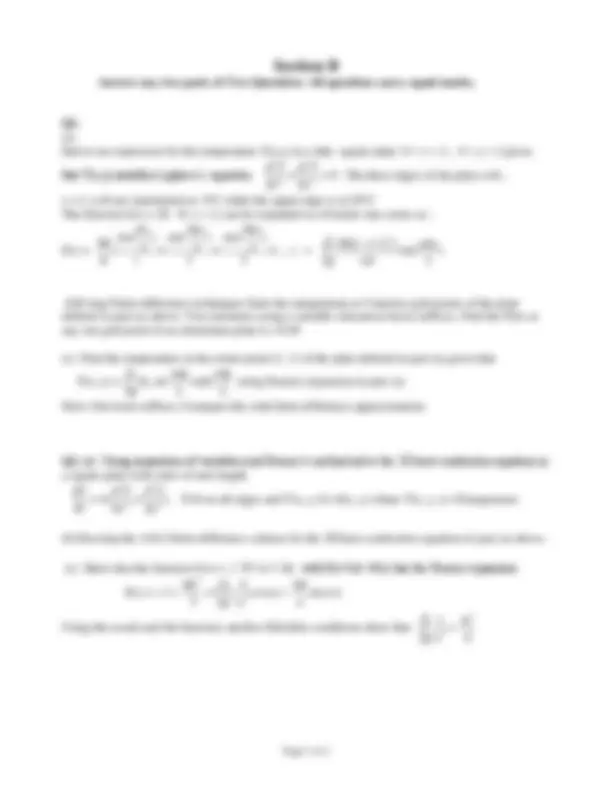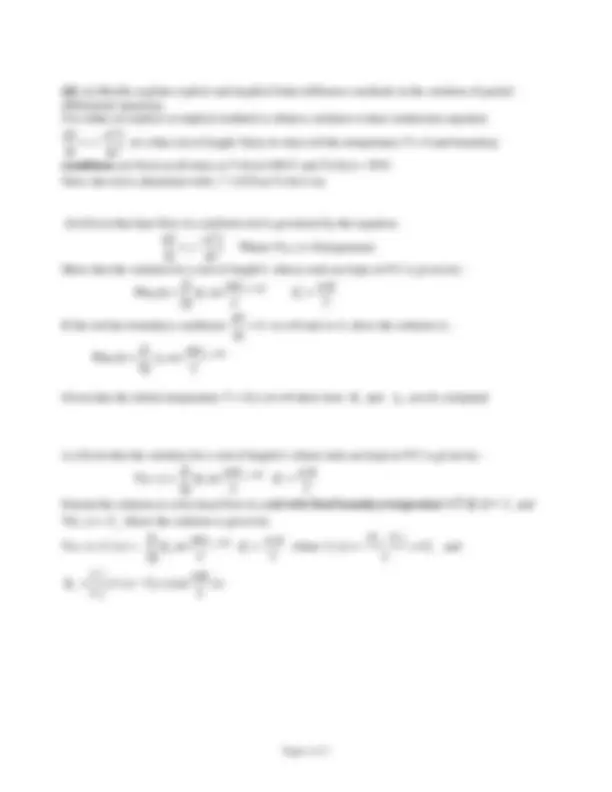




Study with the several resources on Docsity

Earn points by helping other students or get them with a premium plan


Prepare for your exams
Study with the several resources on Docsity

Earn points to download
Earn points by helping other students or get them with a premium plan
Community
Ask the community for help and clear up your study doubts
Discover the best universities in your country according to Docsity users
Free resources
Download our free guides on studying techniques, anxiety management strategies, and thesis advice from Docsity tutors
An exam paper from the cork institute of technology for the module computing & numerical methods 1 (math7015), offered in the school of mechanical & process engineering, bachelor of engineering (honours) in mechanical engineering, bachelor of engineering (honours) in chemical & biopharmaceutical engineering, and bachelor of engineering (honours) in structural engineering programmes. The exam covers topics such as root finding methods, gauss seidel method, newton cotes integration formulae, gauss quadrature, interpolation, extrapolation, and heat conduction equations. Candidates are required to answer all questions in section a and any two parts of two questions in section b.
Typology: Exams
1 / 4

This page cannot be seen from the preview
Don't miss anything!



Autumn Examinations 2010/
Module Code: MATH
School: School of Mechanical & Process Engineering
Programme Title: Bachelor of Engineering (Honours) in Mechanical Engineering
Bachelor of Engineering (Honours) in Chemical & Biopharmaceutical
Engineering
Bachelor of Engineering (Honours) in Structural Engineering
Programme Code: EMECH_8_Y
CSTRU_8_Y
ECPEN_8_Y
External Examiner(s): Dr. P. Robinson
Internal Examiner(s): Dr. R. Sheehy, Dr. P. Robinson
Instructions: Answer ALL questions in Section A.
Section B – Answer any two parts of TWO questions.
All questions carry equal marks.
Duration: 2 Hours
Sitting: Autumn 2011
Requirements for this examination:
Note to Candidates: Please check the Programme Title and the Module Title to ensure that you have received the
correct examination.
If in doubt please contact an Invigilator.
SECTION A
ANSWER ALL PARTS.
Q1. Describe any two of the following methods for obtaining roots:
Bisection, Newton Raphson, False – Position
Explain the terms convergence and stability as applied to numerical
Methods for obtaining roots and show that;
'
2
f x f x
root)
Use root finding techniques to estimate
3 3 .Two iterations suffices
Q2. Describe the Gauss Seidel Method for solving a system of Linear Equations.
Briefly describe the main pitfalls in using Gauss Elimination Method and list techniques for
improving the solution.
Illustrate using a suitable example an ill – conditioned system.
Q3. (a.) Briefly describe the rationale behind:-
(i) Newton Cotes Integration formulae and
(ii) Gauss Quadrature.
.
(b) Use two point Gauss Quadrature to evaluate the
Integral of f ( x ) =
2 x between the limits x = 0 and x = 1
Compare result with the exact solution.
(c) Use central difference formulae of 0(h
2 ) to estimate
the first and second derivative of f ( x ) =
3 x at x= 0.5 step size h =0.
Use Richardson’s extrapolation to obtain 0(h
4 ) estimate of the first derivative at x = 0.
Q4. (a) Briefly describe the terms:
(i) Interpolation
(ii) Extrapolation.
(b) The points (1, 0), (4, 1.386), (6, 1.792) lie on the curve f(x) = ln( ) x
Fit a 2nd order interpolating polynomial to the data and use it to estimate
ln(2)
Q3. ( a) Briefly explain explicit and implicit finite difference methods in the solution of partial
differential equations
Use either an explicit or implicit method to obtain a solution to heat conduction equation
2
2 2
x
c t
in a thin rod of length 10cm.At time t=0 the temperature T = 0 and boundary
conditions are fixed at all times at T (0,t)=100°C and T(10,t) = 50°C
Note: the rod is aluminum with
2 c =.835cm ²/s h=2 cm
(b) Given that heat flow in a uniform rod is governed by the equation
2
2 2
x
c t
Where T(x, t) =Temperature
Show that the solution for a rod of length L whose ends are kept at 0°C is given by:-
T(x, t) =
2
1
sin n^
t n n
n x B L
cn n
2
If the rod has boundary conditions 0
x
at x=0 and x= L show the solution is:-
T(x, t) =
2
1
cos n^
t n n
n x A L
Given that the initial temperature T = f(x) at t=0 show how Bn and An can be computed
(c) Given that the solution for a rod of length L whose ends are kept at 0°C is given by:-
T(x, t) =
2
1
sin n^
t n n
n x B L
cn n
2
Extend the solution to solve heat flow in a rod with fixed boundary temperature’s T (0, t) = T 1 and
T(L, t) = 2 T .Show the solution is given by:
T(x, t) = T 1 (x) +
2
1
sin n^
t n n
n x B L
cn n
2 where T 1 (x) = 1
x T L
and
Bn = dx L
n x f x T x L
L
( ( ) ( )) sin
0